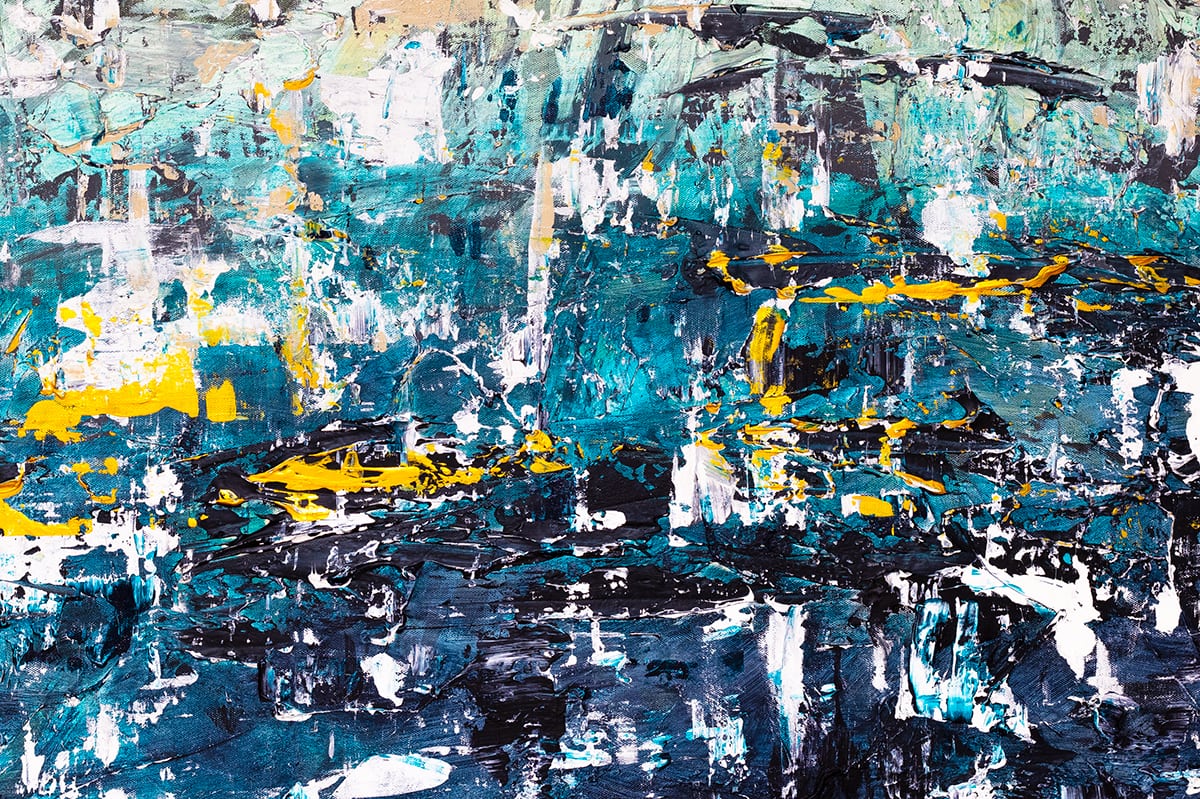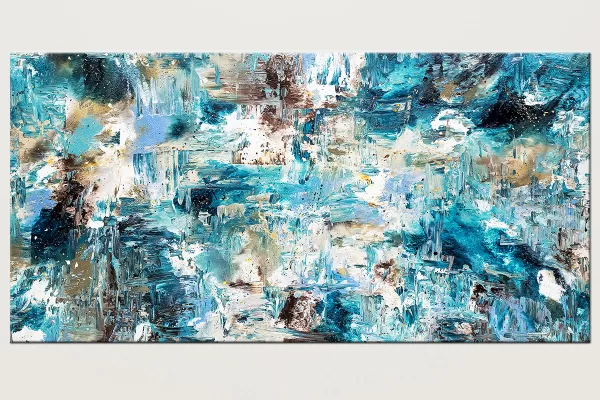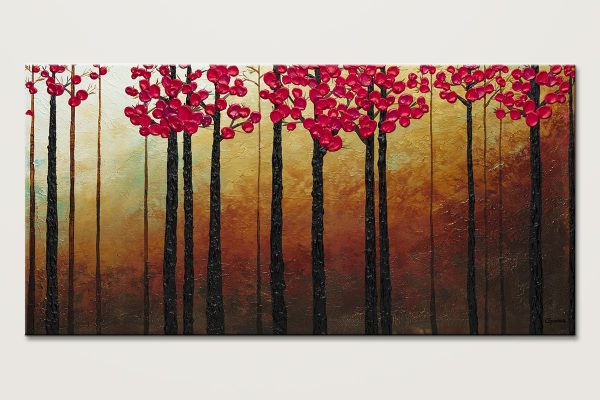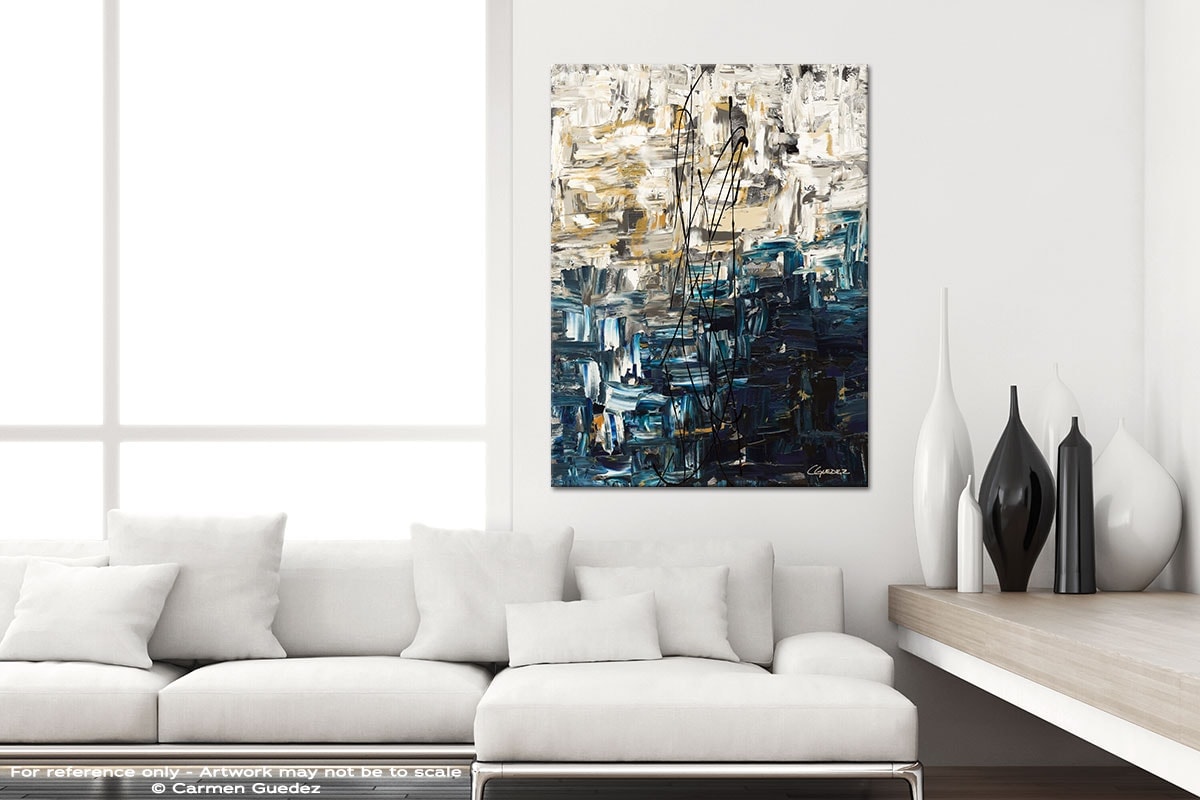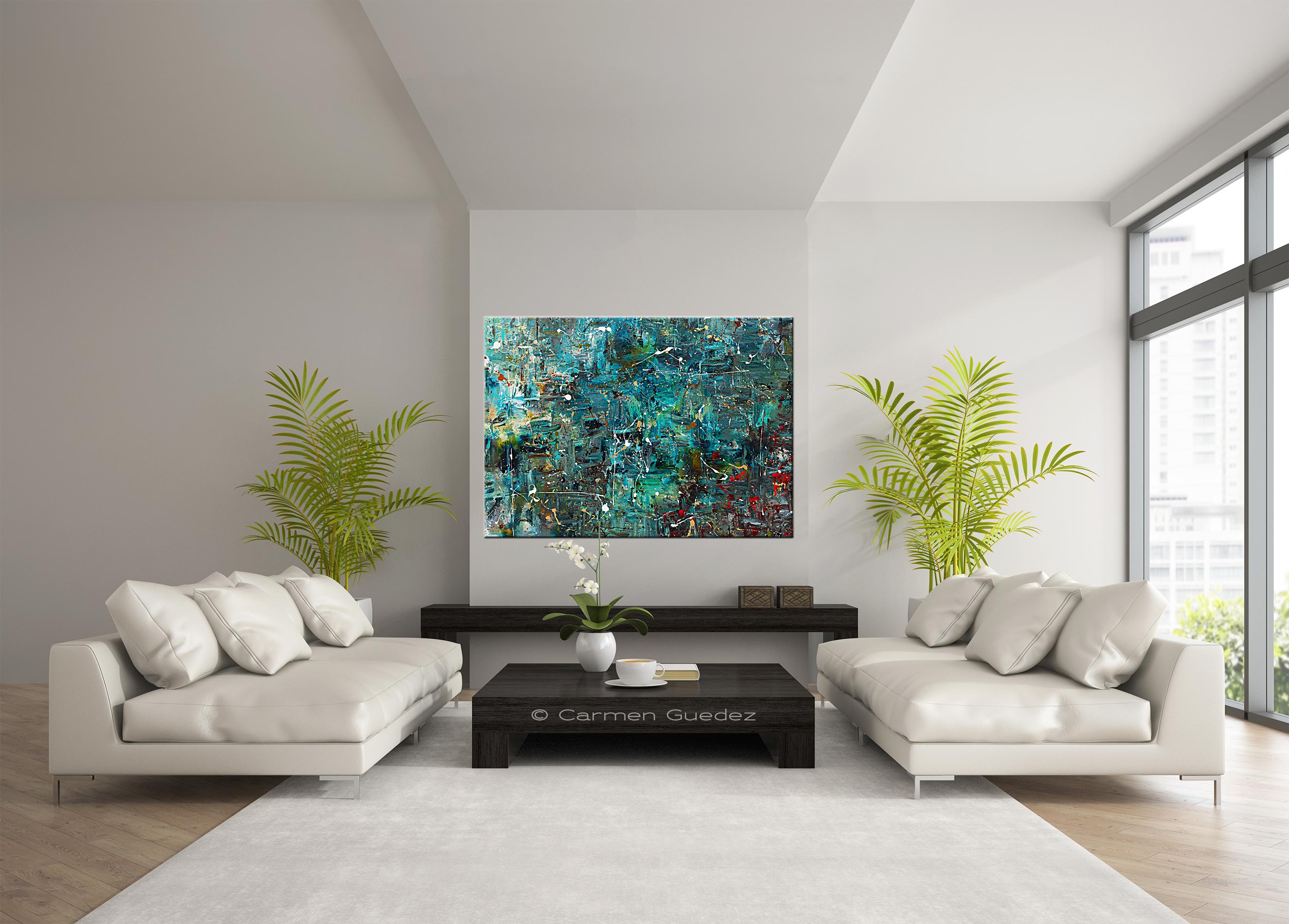Abstract Art
What is abstract art? It’s art that throws out realistic images and tries to express feelings thoughts through form, line, color, composition, and rhythm alone. While there are many examples from cultures around the world, Western art only gets abstract at the beginning of the 20th century. If you are interested in buying abstract art, there are many places you can find it — from local galleries and art fairs to ecommerce options like online art marketplaces and artist websites. The best way to purchase original abstract art is directly from the artist, and we explain why. With proper handling and care, these can deliver positive energy, happiness and incredible beauty and depth of emotion for many, many years to come.
Abstract art is one of the most exciting and wide-ranging fields in art. Despite that, many people feel intimidated when they first try dipping their toe into it.
Even though these works can become cornerstone pieces in your collection and inspiring art for your home or office, many people don’t know how to get started.
With a little understanding and an open mind, abstract works can become some of the most enjoyable art experiences available. That’s why this single approach has revolutionized so many fields over the last hundred years.
From abstract canvas art to sculpture and even music — nothing in the art world hasn’t experimented with abstraction.
Let’s dive into the basics, from answering what abstract art is, how to appreciate it, and — when you’re ready — how to buy it.
What Is Abstract Art?
Art Deco, more a style in architecture and illustrative design, also took the western world by storm. It found new ways to articulate facades, changed the classical proportions of living spaces, and brought a feminine elegance to public environments. Posters, newspapers and books were festooned with Art Deco flourishes and the revival of dark and mystical folk-lore themes. New techniques in stained glass, ceramics and architecture meant that more novel things were being made, being bought and being used. The government-supported economic boom of the 1920s resulted in thousands of Art Deco artisans being engaged to decorate buildings that were erected during that time, to the degree that some you can only ever see from the top deck of a bus as you tour the streets of New York.
Abstract art, also called nonobjective art or nonrepresentational art, [is] painting, sculpture, or graphic art in which the portrayal of things from the visible world plays no part. — Britannica
Before we define what it is, let’s talk about representational art.
Representational art is one of the types of “Visual Arts” that tries to accurately portray things we see. When you look at a realistic painting of a flower or a historical battle, you’re looking at representational art.
This style dominated European art for centuries, especially with the rise of the Renaissance values of perspective and form. It became a foregone conclusion that art would try to look realistic. In the 15th to 19th centuries, all the greatest European artists worked hard to master and discover techniques of representation.
But that isn’t the only way to depict something — and you don’t even have to depict anything at all! That’s where abstract art shines. It tries to portray abstract ideas or to show something in a new, non-realistic way.
While there was an explosion in Western abstract art in the 20th century, many cultures had already experimented with abstraction long before. A few examples of historical abstract art include:
-
- Islamic art
- Chinese art from the Tang Dynasty
- Southwestern Native American art
In some cases, these cultures used entirely abstract, geometric figures, like Islamic art. Others played around with depicting the real world in abstract ways, like some Tang dynasty artists. Still others combined abstract shapes and abstracted images of real world creatures in their designs, like many Southwestern Native American styles.
So, to summarize, if a work of art deals in abstract ideas or portrays real things in strange and non-representational ways, it is abstract art.
History of Abstract Art in the West
In the West, abstract art came out of the Impressionist movement of the 19th century. These artists, like Claude Monet, were breaking down what they saw into simpler colors and lines — that is, they were getting the mere “impression” of what they saw.
The post-impressionists pushed things further by the turn of the 20th century. Artists like Vincent Van Gogh were moving further and further away from what they saw and into how things felt. These pioneers inspired others like the Cubists and the Fauvists who went even further into abstraction.
The Cubists threw away with traditional ideas of perspective and linear time, leading to many of the masterpieces of Pablo Picasso. The Fauvists like Henri Matisse, meanwhile, were focusing on surprising color choices. They would still paint scenes, portraits and landscapes — but the colors were not representational, like purple skies, blue hair and other unexpected colors.
As we can see, these painters were all part of a long journey out of representational art. That’s how strong a hold it had on European sensibilities. It took generations of masters choosing to go a little further into the wilderness of abstraction before purely abstract work could be created.
But after the breakthroughs of the Cubists and Fauvists and others like them, European artists were ready to fully embrace abstraction. Artists like Wassily Kandinsky began going wild, pursuing expression without direct representation. By the 1920’s, abstract art was off to the races.
Over the course of the 20th century, many new names arose. Mark Rothko painted large fields of color. Barnett Newman played with powerful yet simple compositions. Jackson Pollock flung paint on a canvas to capture his vision.
How to Understand Abstract Art on the Wall

When looking at an abstract work on the wall — like the above canvas print “Safe and Sound”, one of Carmen Guedez’s best selling abstract art featured on the Overstock website, you’ll be confronted with details, but it might not “look” like anything. That’s okay!
Original abstract art will still create interest on the canvas, you just have to open up to your real feelings. How do the colors work together? Where does your eye land first? Does the painting make you feel anything or think of anything? After you look long enough, some paintings will begin to look like something — a bizarre landscape or maybe a portrait. Moreover, abstract paintings can even bring a calmer feel, good energy to a room, and be a personal healer during stressful times.
SIDENOTE: Sometimes artists will repeat certain shapes, or they will highlight certain colors. That’s the exciting (and sometimes confusing) part of this genre: there are so many different ways to do it.
There are a few things you can do to get your bearings when looking at a work whether it is an abstract wall art on canvas, sculpture, or any other visual medium. A few tips to help you get started:
-
- Don’t “try” to understand it, let yourself absorb the feeling of the painting
- Begin to ask yourself questions, like how it makes you feel or what it reminds you of
- If you know other work by the same artist, ask yourself how this piece is similar and different
These make for helpful jumping off points, but the ultimate test is whether or not you like it.
How to Find Abstract Painting for Sale
With some artistic talent, you can create a simple acrylic abstract art. You can find many videos online just by searching “DIY Abstract Art”. If painting is not one of your skills, there are many places you can find artwork, from galleries and art fairs to online ecommerce portals like online marketplaces or artist websites.
In fact, we are lucky to live in a time with so much art available. But that produces its own problem. Because with so much available to buy, how do you pick?
Finding great pieces can be a wonderful adventure with the right attitude and tools. And if you keep your tastes and budget in mind while navigating all the different marketplaces, you are sure to find that perfect work of art for you.
Find Styles You Love
The first thing you want to do is whet your appetite and build up a sense of what you like. Now, the internet has made this easy and smartphones have made this incredibly convenient.
Online image sharing platforms like Pinterest and Instagram allow you to cultivate an endless feed of great abstract art. This can be a fun way to pass your free time while you’re waiting for a bus or have a few minutes in the morning.
SIDENOTE: What is particularly powerful about Instagram is that you can even connect directly with artists you really enjoy.
But while the internet might make research easier, it’s far from the only way to do it. Going to art museums or galleries near you is a rewarding way to spend your time and helps by showing you art in person — the best way to view it.
You can also find large format art books in any library or local bookstore. These books will often have interesting information on the artists and insights into the technique, materials, and styles being employed.
Pick a Budget
With your tastes sharpened, it is time to think strategically about how you’ll spend your money. It is always good to set out a budget. This can help you keep your love for art within your means.
For collectors working on a smaller budget or just starting out, fine art prints of abstract paintings can be a great place to start. These are less expensive, and with the high quality paper and inks available today, they can make a great impression.
Prints, such as posters, canvas, acrylics, and even on metal and wood, are especially helpful if you have a limited budget.
If you are looking to have works of art that might sell for as much if not more than you bought them for, you’ll want to be careful about the prints you purchase. If you want them to retain and appreciate in value, be sure to always buy limited edition prints. These will come numbered and with paperwork proving provenance. Because they are limited to a certain number of prints in a run, you know how many prints like yours exist in the world.
Alternatively, open edition prints are available at a great value to the customer. These can be printed over and over again by the artist, so the number of prints just like yours can’t be guaranteed, and that is just fine.
In contrast to a flat print — that is manufactured in large quantities, original paintings are more expensive and more as an investment because they are created directly by the hand of the artist. They are one-of-a-kind pieces you won’t find anywhere else. These works provide a more engaging and enriching experience and require to have a bigger budget.
Time to Find
It’s now time to really look for what’s available. There are some great places to find abstract art for sale, including:
-
- Galleries in your area
- Art fairs
- Online art marketplaces
- Artist websites
If you live in an area with a thriving arts district, they will typically have plenty of galleries for you to peruse. Gallerists are more than happy to talk about what you like — after all, they want to sell you art you love! They can keep an eye out for abstract art you’d be interested in or point you to work they have that fits your tastes.
Art fairs are another good option. Most areas host art fairs through the year. This gives you the added benefit of buying from the artist, allowing you to strike up a conversation and learn about their process, which can add to your experience.
Online marketplaces and galleries can be a good place to find art, too — especially if you live in an area without many brick-and-mortar galleries.
Last but not least, you can visit artist websites. Like art fairs, these allow you to buy directly from the artist, reducing the margin on your purchase while supporting the artist. These sites will almost always have information on the artist, their process, their biography, and news about their career. Similarly, you can often buy work directly from social media profiles of artists:
Out of all the options out there, buying original abstract art directly from the artist is the best way. Why? Well, wouldn’t it be awesome to own a unique abstract painting from artists you have met, spoken to or follow on social media?
Yes, absolutely! Building a personal connection with the artists allows you to learn about their creative process and inspiration, therefore gaining a deeper appreciation for the art itself. Through social media, some artists show more about their personal lives, what they like, what they do during their free time, what music they listen, the food they eat, etc.
From a business perspective, here are some advantages:
-
- The final purchase is more enjoyable because it develops a special, individual bond with the artwork. You will hang your original abstract painting with a much more sense of satisfaction.
- You receive indisputable proof of authenticity. Most artists will provide a certificate of authenticity with their signature, stamp, date and other information.
- When your friends comment on the piece, you can have a personal story to share about the artist or the inspiration behind the art.
- It enables the collection and commissioning of artworks that suit your needs and match your décor. Often, you can work with the artist on suggested works to match your room or commission custom works with your color and size preferences, for example, an extra large abstract canvas art.
- You have the possibility of making an offer or asking for a discount. If the original painting is above your budget, some artists are willing to negotiate. Most of the time, the original art ships from the artist’s studio. The artist could offer free shipping or deliver the artwork personally, if it’s local.
- By staying connected to the artist’s social media accounts or newsletter subscription, you can be the first one to find out about new original art and special offers.
- All of the proceeds go to the artist. It skips intermediaries’ fees and commissions from agents, publishers, big art companies, galleries, etc.
- It uplifts and helps the artists to make a living doing what they love.
Handling and Caring for Your Art
Once you’ve purchased the artwork, you now bring it into your living space. While the journey of buying it is over, you still need to know a few things to keep your art looking great.
Poor handling and care for art is a great way to lose value in your piece and potentially ruin it completely. While it isn’t difficult to do it the right way, it’s almost impossible if you don’t know how.
If you own an abstract art print or canvas, proper handling and care includes:
-
- Hanging out of direct or excessive indirect UV light, or covering in UV resistant glass
- Keeping out of humid areas, like bathrooms or basements
- Keeping work at a constant temperature, around 70 degrees
- Dusting with soft brushes and gentle strokes
- Keeping above zones where children or pets might cause damage
- Washing your hands before touching, and wearing cotton gloves if at all possible
- Keeping away from harsh chemicals
- Never stacking work when moving, instead covering in plastic, cushion, and place in rigid containers
- Educating any movers who might not know how to handle your piece
As you can see, many of these require just a little bit of added thought when choosing where to hang your piece. Be especially aware when making a big move, though. These are often stressful times where details get swept away because we are so anxious to get things done — but moves are a major risk for works of art.
BOTTOM LINE: If you properly care for original abstract art or prints, you’ll find that they can last at pristine quality for decades, even centuries. This allows you to enjoy it for years to come and hand down your pieces to future generations of art lovers.
Tying Everything Together
The world of abstract art is a fascinating place, full of wonders waiting for you to discover. With the information above, you’ll be able to understand what you are looking at, where to look for work to buy, and what to do when you want to take one home.
As a final note, it should be emphasized that it is a buyer’s market out there for work of any kind — and abstract art is no exception. You can purchase fine art reproductions in a myriad of materials and styles, and you have access to more artwork than art buyers of any era before. Buying original art from emerging artists is an investment and an exciting experience that connects you to the person who created the artwork. Only a small number of artists make a living selling their work. By obtaining directly from them, you are contributing to the success of their small business and making future works possible.
That really makes this a golden age of art buying. And with the information above, it’s time for you to join it.

